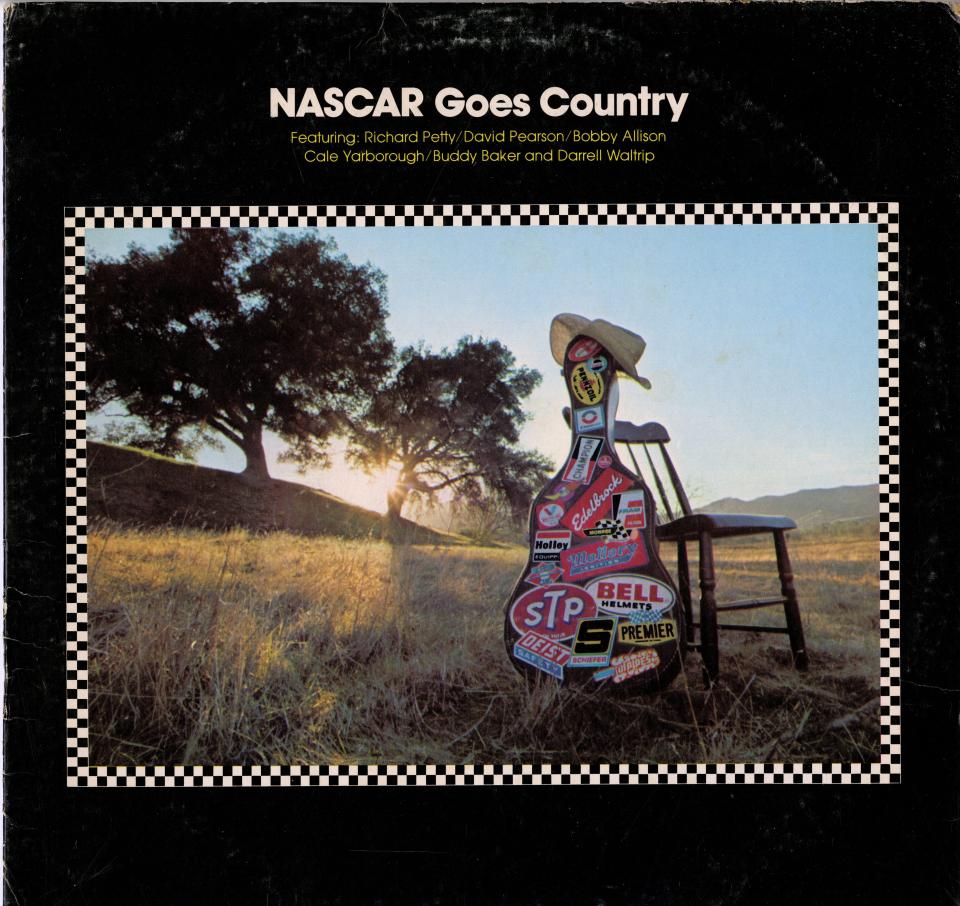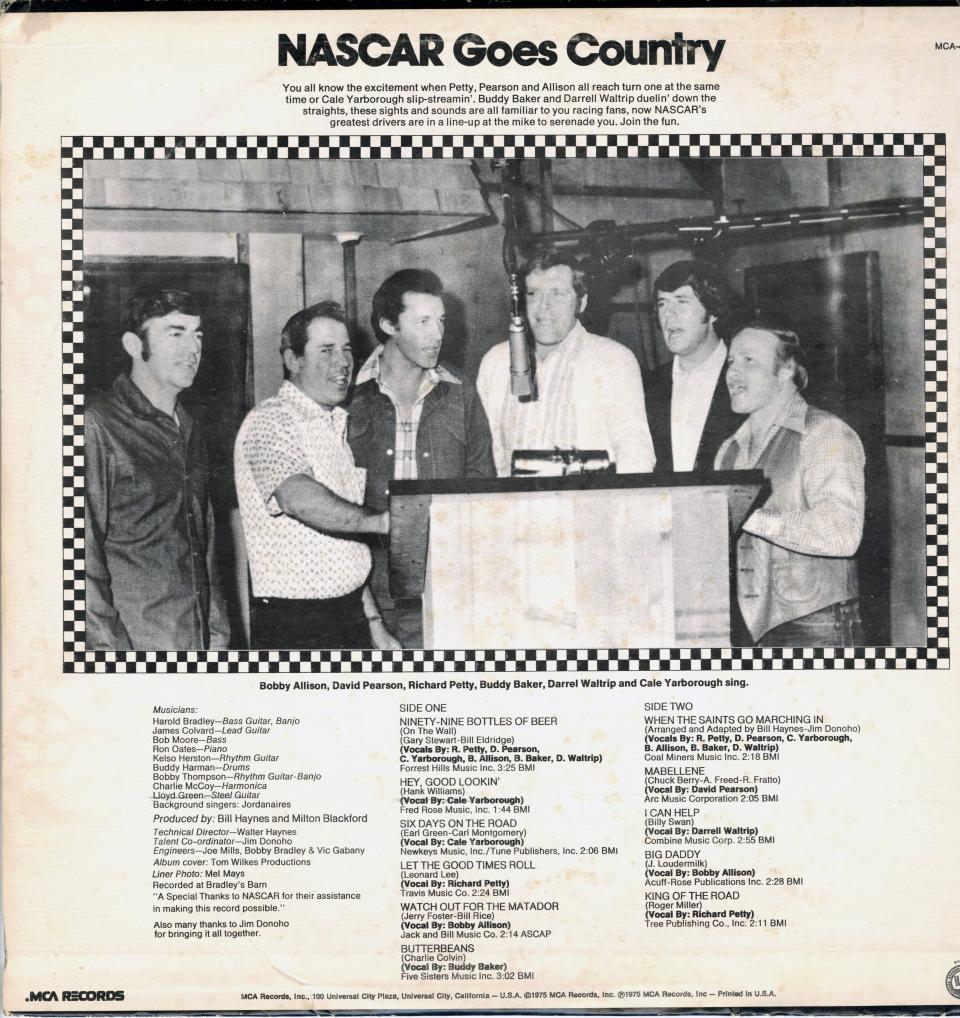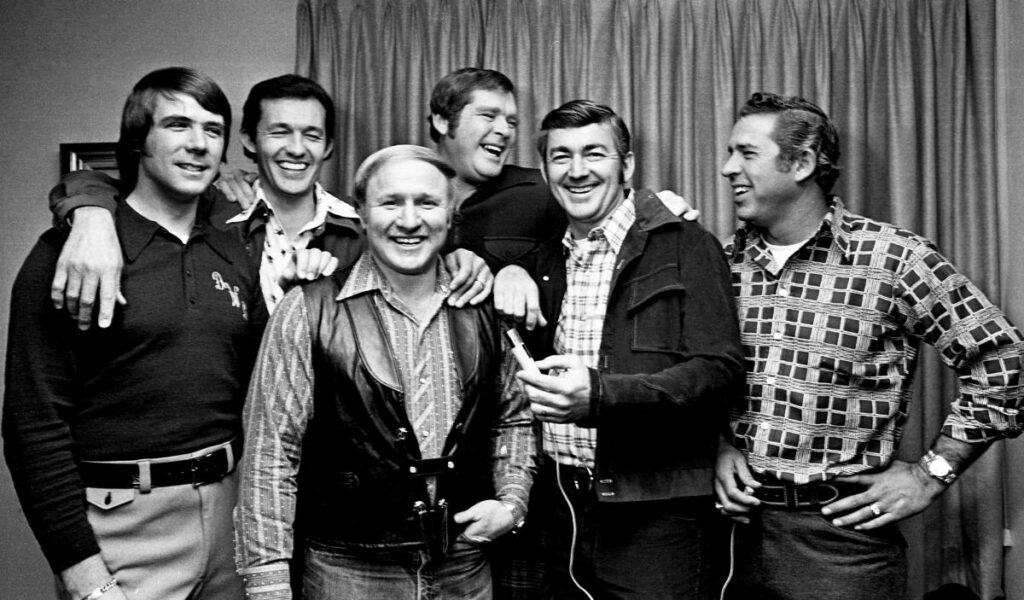NASCAR’s relationship with country music is not new.
It’s the reason many were happy to see NASCAR Cup racing return to the Music City area at Nashville Superspeedway in 2021 and would like to see it come back to Nashville Fairgrounds Speedway as well. A deal to make that happen is still being discussed between Bristol Motor Speedway and the Metro Council.
The connection between honkytonks and high bank turns was never stronger than in the mid-1970s. That’s when Jimmy Donoho, publicity director at Nashville Fairgrounds Speedway at the time, came up with the idea to have some of the NASCAR circuit’s top drivers trade there stick shifts for microphones and cut a county music album titled “NASCAR Goes Country.”
A half-dozen of the country’s top NASCAR drivers met in town on Jan. 2, 1975, to try their hand at making a record instead of breaking one. They are Darrell Waltrip, left, Richard Petty, Cale Yarborough, Buddy Baker, Bobby Alison and David Pearson. The album, to be released in mid-February, is titled “NASCAR Goes Country.”
“Ninety percent of race fans like country music,” Donoho told The Tennessean on Jan. 2, 1975. “and so the album seemed a natural — give ’em country music by some of the country’s top race car drivers. And come to find out, most of the drivers are also country music fans.”
Donoho’s father Bill was president and promotor of Nashville Fairgrounds Speedway at the time.
The album was released by MCA Records in February in time for the 1975 Daytona 500. It was re-released in 2002 by Speedway Records.
Richard Petty, Darrell Waltrip and other NASCAR greats recorded country music album
Donoho invited a half-dozen of NASCAR’s top drivers to chime in including Richard Petty, Darrell Waltrip, Cale Yarborough, Buddy Baker, Bobby Allison and David Pearson. That group collected a total of 586 NASCAR Cup victories in their respective careers.
Petty, 37 at the time, had already established himself as “NASCAR’s King” and Waltrip was a rising star who would go on to win his first Cup race five months later in the Music City 420 at Nashville Fairgrounds Speedway.
Five years earlier Baker had become the first driver to break 200 mph on a closed course, reaching 200.447 mph at Talladega Superspeedway. Allison had already won 44 NASCAR races, Pearson had won three NASCAR championships (1966, 1968 and 1969) and Yarborough was on the cusp of winning three straight NASCAR championships (1976, 1977 and 1978).
“It was Jimbo Donoho’s brainchild and he had a foot in both worlds − racing and country music,” said former Tennessean NASCAR writer Larry Woody, who attended the recording session. “With his dad running the track, Jimbo knew all the drivers and they all seemed to like him. And in country music he had done some PR work. I don’t know if anybody else could’ve pulled it off other than Jimbo Donoho, but for him it wasn’t that difficult.”
How the Jordanaires, Charlie McCoy, Harold Bradley and other music legends helped NASCAR drivers carry a tune
No corners were cut in the production of the album. It was produced at the world famous Bradley’s Barn recording studio in Mt. Juliet where such country greats as Johnny Cash, George Jones, Loretta Lynn, Conway Twitty, Jeannie Seely, Charlie McCoy and many others recorded.
In fact, McCoy took part in the recording of “NASCAR Goes Country” playing harmonica while the legendry Jordanaires sang backup.
Country Music Hall of Famer Harold Bradley, co-owner with his brother Owen of Bradley’s Barn, played banjo, guitarist Bob Moore, who did sessions with Elvis Presley and Roy Orbison, was on bass, and Lloyd Green, who worked the year before with Paul McCartney and Wings on “Junior’s Farm” in Lebanon, played steel guitar.

Album art for “NASCAR Goes Country”
More: There’s now a documentary about that time NASCAR drivers released a country album
Mix the top-notch accompanying talent with the state of the art sound electronics available at the time and the NASCAR serenaders couldn’t fail. At least that was the hope.
Still some in the group worried about crashing in the studio, according to Petty.
“Some of the other guys were pretty nervous about trying to do it,” Petty told Southern MotoRacing newspaper at the time. “But it didn’t bother me, because I had already seen what those cats in Nashville can do with all that equipment to make you sound good, no matter how you really sound.”
Kyle Petty tried to help Richard Petty with his singing
Petty, a North Carolina native who had already established himself as the greatest driver in NASCAR, received some sound advice from his son Kyle, who was 14 at the time and would later establish his own NASCAR career.
After Richard Petty played a first-draft copy of the recording for his family Kyle said, “Daddy, you’re going to have to learn to talk before they’ll be able to teach you to sing,” Richard Petty told Southern MotoRacing.
Not only did Kyle Petty go on to have a 30-year racing career, he also became a country music artist signed by RCA Records who has performed his original music at the Grand Ole Opry.
Which songs did NASCAR drivers sing on the country music album?
The group recorded 11 songs, most covers by artists including Hank Williams, Chuck Berry, Roger Miller and “Little” Jimmy Dickens.
The hit list included an ensemble take on “Ninety-Nine Bottles of Beer (On the Wall) and “When the Saints Go Marching In;” “Let the Good Times Roll” and “King of the Road,” by Petty; “I Can Help” by Waltrip; “Butterbeans” by Baker;” “Hey, Good Lookin” and “Six Days on the Road” by Yarborough and “Maybellene” by Pearson.
The only original song was “Watch Out for the Matador” written for and sung by Allison, who drove a Penske Racing AMC Matador. Bill Rice and Jerry Foster co-wrote the song, which even referenced a $9,100 fine Allison was levied for having illegal parts under the hood in the Los Angeles Times 500 the year before.
The song ends with Allison saying (not singing), “Watch out for the Matador … liable to get that 9,100 back.”
“Watch out for the Matador” is Nashville local auto racing historian and personality Russ Thompson’s favorite song on the album. But he is also fond of “Butter Beans,” a Dickens song covered by Baker because of a prank Waltrip put Thompson up to on the way to a NASCAR Cup race in Atlanta after the release of the album.
It provided a glimpse of the good natured ribbing that went on between NASCAR drivers in that era.
“My dad and I happened to stay at the Days Inn in Griffin (Georgia) and literally in the room next door to us was Buddy Baker’s,” Thompson said. “I already knew Darrell, I’d worked on his crew some, so I went over to see him at the Holiday Inn. I told him we were staying in the room next to Buddy Baker.”
Waltrip, always up for a good practical joke, told Thompson to call Baker’s room when he got back to the Days Inn and pretend to be room service. Then ask where Baker wanted his bowl of butter beans delivered?
Without hesitation, Thompson complied.
“I call Buddy, and I can hear the phone ringing through the wall,” Thompson said. “He answers and I know it’s Buddy because Buddy talked with a lisp. I say ‘Mr. Baker, this is room service. We just wanted to know where you wanted your bowl of butter beans delivered?'”
After a pause, Baker said, “This hotel don’t have no room service.'”

Album artwork for “NASCAR Goes Country”
Thompson still has “NASCAR Goes County” on his iPod playlist.
“Every summer when I’m cutting the grass I’ll listen to songs from the album,” Thompson said. “Some of them were pretty good.”
Reach Mike Organ at 615-259-8021 or on X @MikeOrganWriter.
This article originally appeared on Nashville Tennessean: Richard Petty, Darrell Waltrip, other NASCAR drivers recorded album in 1975
Read the full article here



